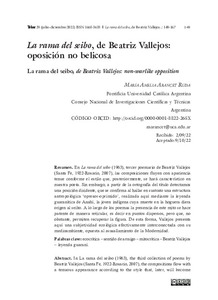Please use this identifier to cite or link to this item:
https://repositorio.uca.edu.ar/handle/123456789/16342| Título: | La rama del seibo, de Beatriz Vallejos: oposición no belicosa La rama del seibo, de Beatriz Vallejos: non-warlike opposition |
Autor: | Arancet Ruda, María Amelia | Palabras clave: | Beatriz Vallejos, 1922-2007; LITERATURA ARGENTINA; POESIA ARGENTINA; LEYENDAS | Fecha de publicación: | 2022 | Editorial: | Universidad Nacional de Tucumán. Facultad de Filosofía y Letras. Instituto Interdisciplinario de Estudios Latinoamericanos. | Cita: | Arancet Ruda, M. A. La rama del seibo, de Beatriz Vallejos: oposición no belicosa [en línea]. Telar. 2022, 29 . Disponible en: https://repositorio.uca.edu.ar/handle/123456789/16342 | Resumen: | Resumen: En La rama del seibo (1963), tercer poemario de Beatriz Vallejos
(Santa Fe, 1922-Rosario, 2007), las composiciones fluyen con apariencia
tenue conforme el estilo que, posteriormente, se hará característico en
nuestra poeta. Sin embargo, a partir de la ortografía del título detectamos
una posición disidente, que se confirma al hallar en sustrato una estructura
antropológica ‘opresor-oprimido’, realizada aquí mediante la leyenda
guaranítica de Anahí, la joven indígena cuya muerte en la hoguera diera
origen al seibo. A lo largo de los poemas la presencia de este mito se hace
patente de manera reticular, es decir en puntos dispersos, pero que, no
obstante, permiten recuperar la figura. De esta forma, Vallejos presenta
aquí una subjetividad ecológica efectivamente interconectada con su
medioambiente, opuesta al avasallamiento de la Modernidad. Abstract: In La rama del seibo (1963), the third collection of poems by Beatriz Vallejos (Santa Fe, 1922-Rosario, 2007), the compositions flow with a tenuous appearance according to the style that, later, will become characteristic of our poet. However, based on the spelling of the title, we detect a dissident position, which is confirmed by finding an ‘oppressoroppressed’ anthropological structure in the substratum, carried out through the Guarani legend of Anahí, the young indigenous woman whose death at the stake gave rise to the seibo. Throughout the poems, the presence of this myth is evident in a reticular manner, that is, in scattered points, but which, nevertheless, allow the figure to be recovered. In this way, Vallejos presents in this book an ecological self effectively interconnected with her environment, opposed to the subjugation of Modernity. |
Cobertura Temporal: | Siglo XX | URI: | https://repositorio.uca.edu.ar/handle/123456789/16342 | ISSN: | 1668-3633 | Disciplina: | LITERATURA | Derechos: | Acceso abierto | Fuente: | Telar No.29, 2022 |
| Appears in Collections: | Artículos |
Files in This Item:
| File | Description | Size | Format | |
|---|---|---|---|---|
| rama-seibo-beatriz-vallejos.pdf | 212,18 kB | Adobe PDF |  View/Open |
Page view(s)
62
checked on Apr 27, 2024
Download(s)
66
checked on Apr 27, 2024
Google ScholarTM
Check
This item is licensed under a Creative Commons License

